This week's tablehopper: strike it rich.
The South Side at Comstock Saloon.
Oh, hello rainy weekend. I’m going to consider it a productivity booster. But right now, here’s your little afternoon tablehopper break, which will not be contributing to your productivity. To your waistline, yes. To your BAC level, quite—especially with this week’s piece of fresh meat review of Comstock Saloon. Consider it your warm up and excitement-builder for Sunday’s Repeal Day festivities—the Barbary Coast Conservancy of the American Cocktail and the new Boothby Center for the Beverage Arts are going to be hosting quite the event, starting at 6pm.
And as you’re doing your holiday shopping, this week’s bookworm review of The Essential New York Times Cookbook just may inspire you to pick it up for the cooks in your lives. (It also can help insure some good meals in your future.)
Cheers to the weekend,
fresh meat
New Restaurant Reviews (I'm looking for somewhere new to eat)
Comstock Saloon
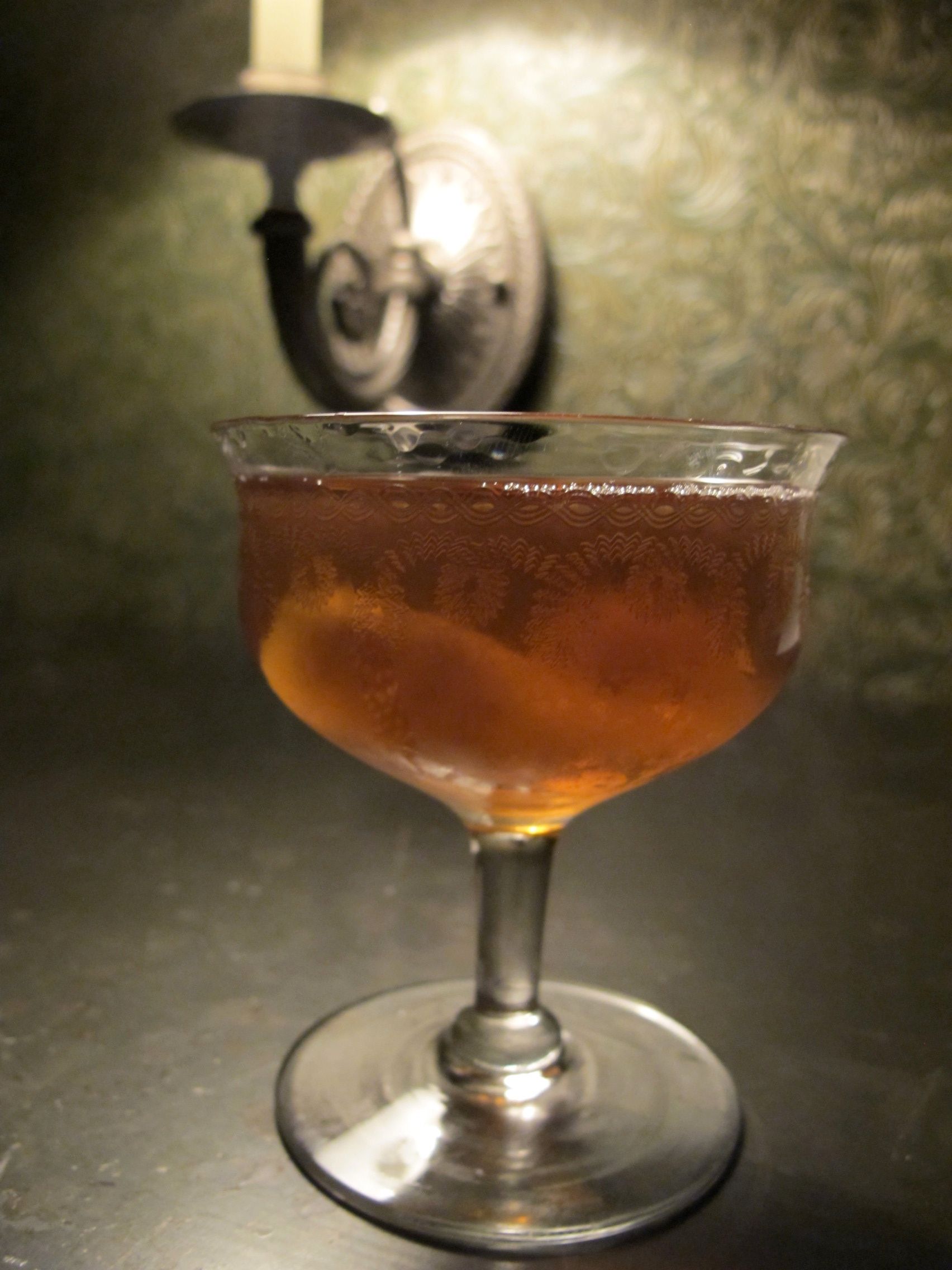
The Martinez.
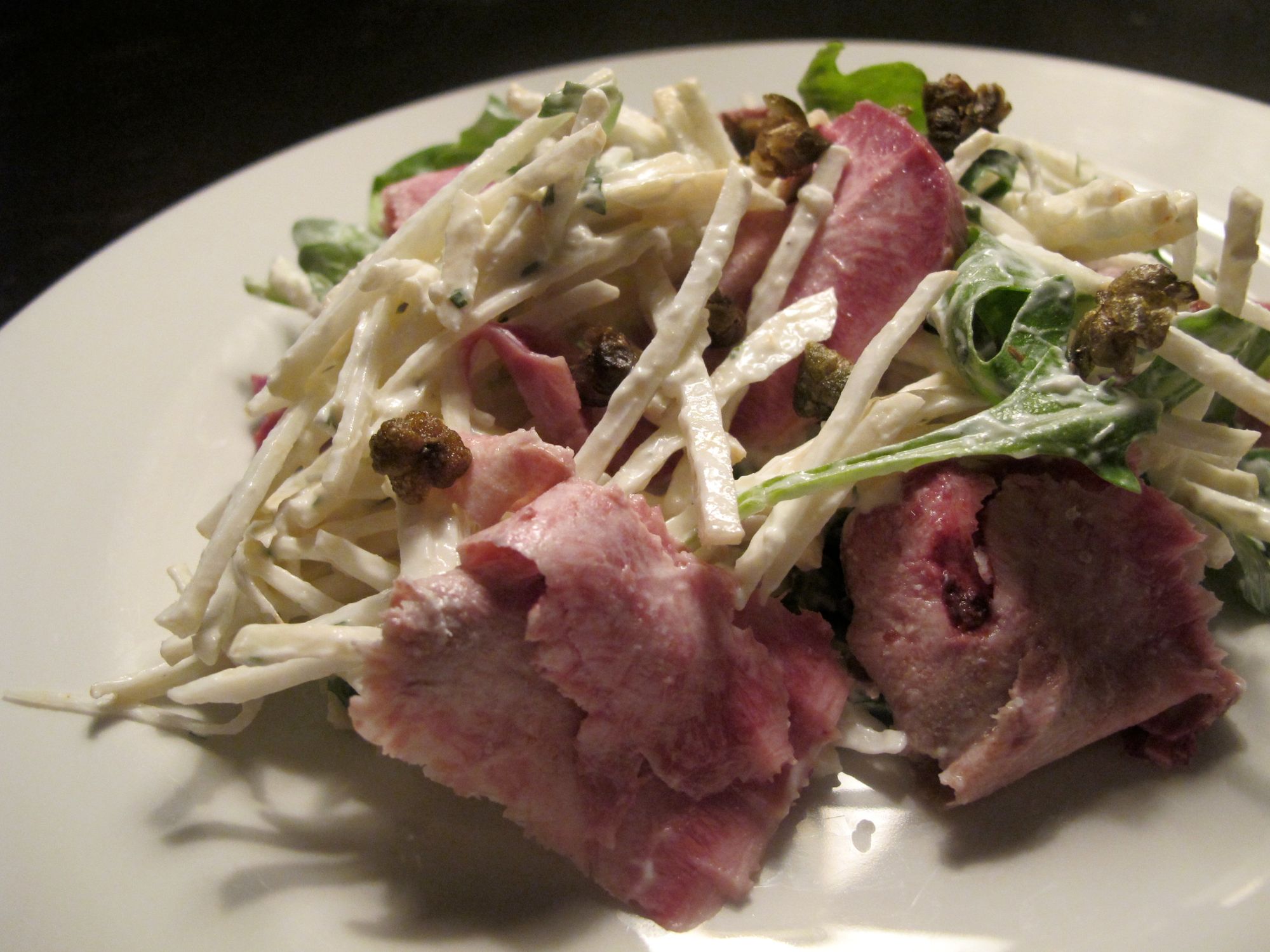
Beef tongue and celery root salad.
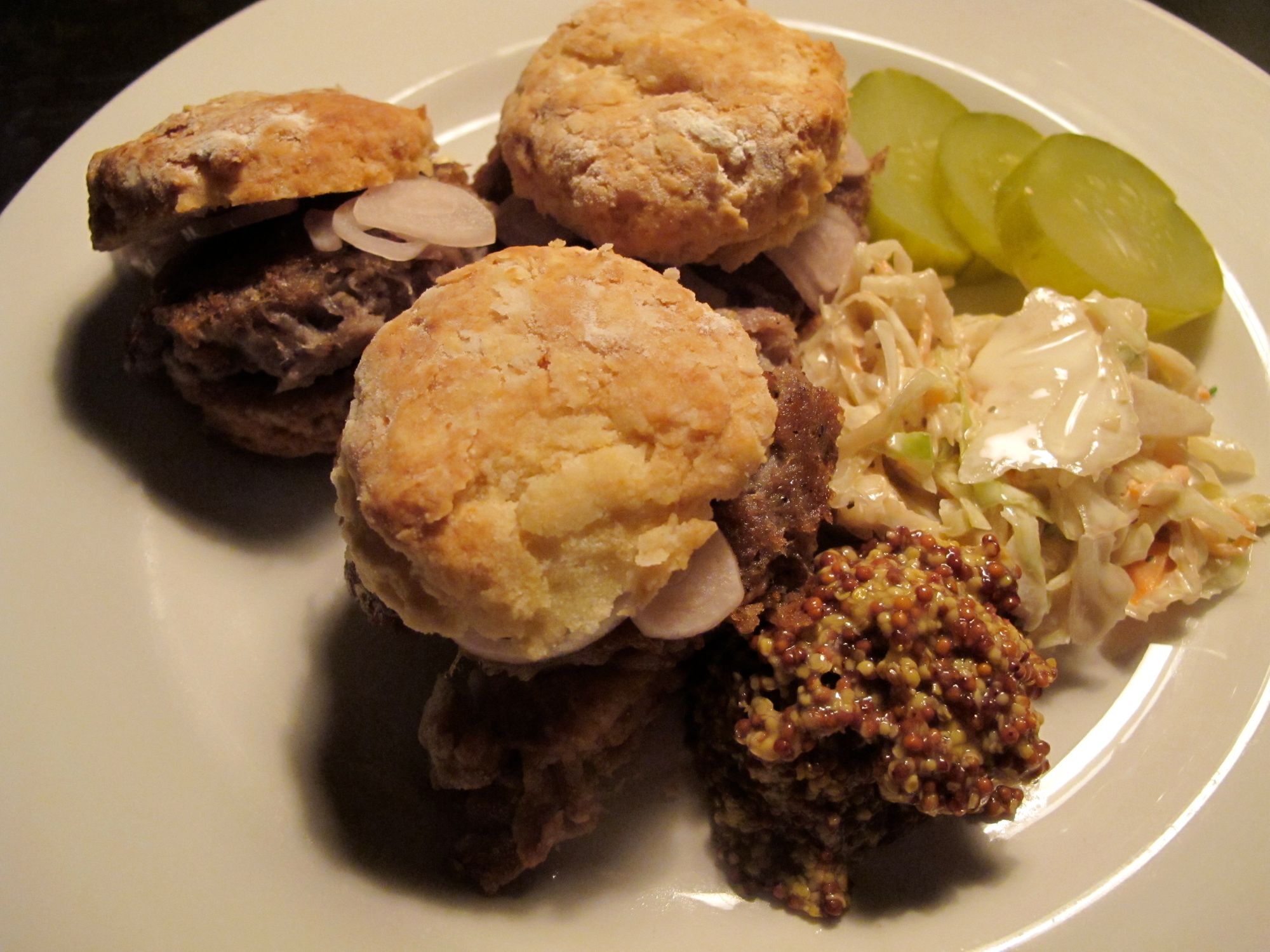
Pig in a biscuit.
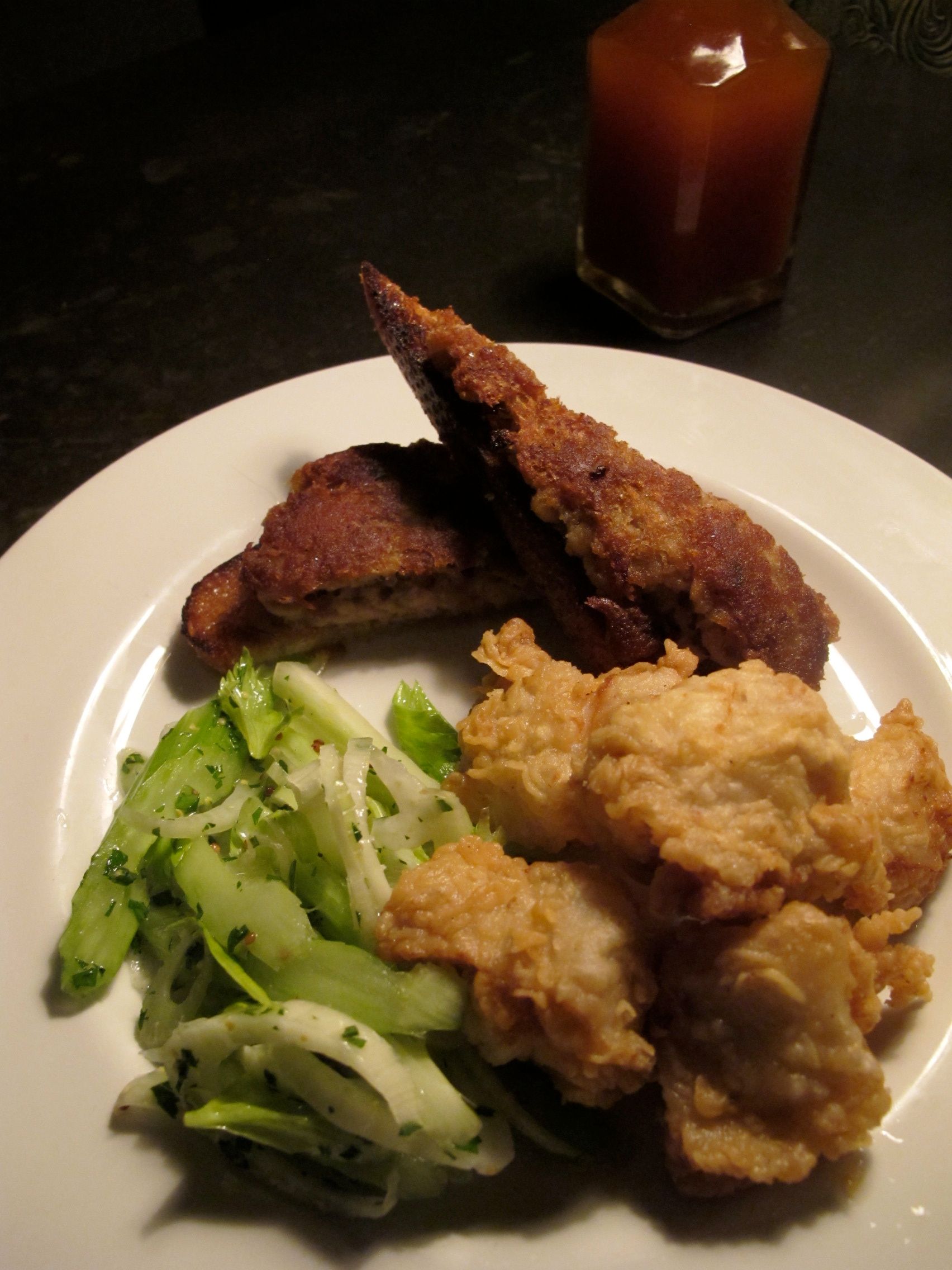
Chicken-fried rabbit.

Maple bourbon pudding.
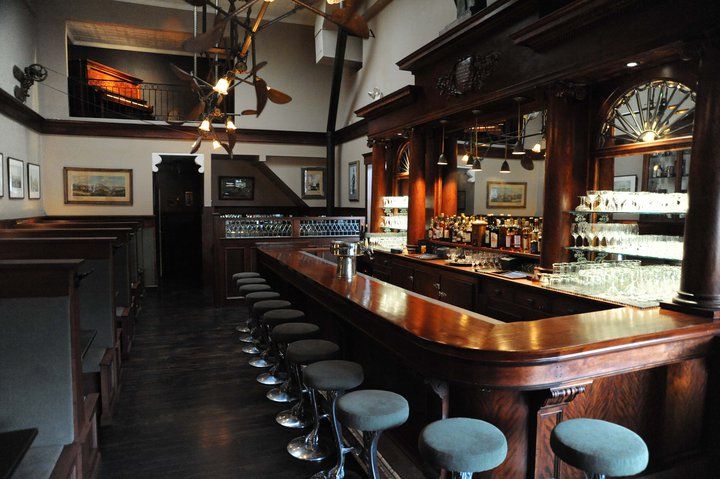
Bar photo © Liza Gershman 2010.
The cocktails at COMSTOCK SALOON are so good, you could be tempted to drink your dinner. Quite. But that would be a bleary-eyed drunk’s mistake, because trust me, you don’t want to miss out on the goldmine (heh, couldn’t resist, sorry) of tasty and satisfying eats here as well.
Local boozehounds have known the bar magic of Comstock owners Jonny Raglin and Jeff Hollinger in this town for a while, shaking it up behind the stick at Absinthe for many years. These two gents love and live by the way of the stirring spoon, and have painstakingly restored this historical Chinatown (just bordering North Beach) saloon that dates back to 1907. And they know their stuff: Hollinger is also a co-author of The Art of the Bar, and a founder of the Barbary Coast Conservancy of the American Cocktail and the newly opened Boothby Center for the Beverage Arts. And for a while there, Raglin was sporting such a legit turn-of-the-century handlebar mustache (waxed up into cheeky little curlicues) that I was convinced I was in a time machine every time I walked in the joint. (The nightly live music, ranging from ragtime to jazz, only adds to the vintage vibe.)
The place has been a hit—proving that locals will drive crosstown to Chinatown/North Beach when the getting is good. The 13 coveted seats at the original wood bar are hung onto like precious gold bouillon—and the cool, high-backed wood booths across from the bar are almost always filled up with diners and drinkers alike. Things can get a little packed at the bar, especially if a large group comes in and has nowhere to really park it, but just bide your time and the doctor will be able to see you soon.
If you’re in the mood for something refreshing (or hungover and need to start light), the South Side cocktail ($8; gin, lemon, sugar, mint, seltzer) is dangerously quaffable—this brown liquor drinker loved it. But it was the Martinez ($12) that was a total bordello-rocker, a combination of Ransom’s Old Tom gin, Carpano Antica vermouth (a fave of mine), Luxardo maraschino liqueur, and bitters. I think it’s my new poison, especially with the Carpano. You can also do “barkeep’s whimsy” for $10—with great results. Just steer your trusty barkeep toward a flavor profile you like (bourbon? pisco? spiritous? refreshing?) and see what happens.
So, were you eyeing that plate of toast points and eggs that your bar neighbor was munching on? Oh yeah, there’s a lot more going on there than meets the eye: those are the pickled eggs ($6.50), cleverly served “Hangtown” style with a touch of oyster dressing, and topped with little bites of crispy bacon. Another snack-tastic winner, the cheddar crackers (imagine cheesy Wheat Thins) and pepper jelly ($4), accompanied by a hearty dollop of whipped cream cheese (we happily discovered this dish is a natural alongside an Old Fashioned). And I haven’t even told you about the pig in a biscuit ($12).
That porky plate comes with three golden and flaky little biscuits, stuffed with lightly browned patties of pork rillette (yeah, you read that correctly) and pickled shallot, with tangy coleslaw, housemade bread and butter pickles, and stone-ground mustard on the side. Everything was so balanced, never getting too rich with all the nicely acidic accompaniments. The dish has a whiff of old school to it—like it’s something the wife of the saloon owner would pack up and wrap in a cloth napkin for her husband’s midday supper.
Another winning entry in the “easy to eat while I have my other paw on my cocktail glass” category is the golden chicken-fried rabbit ($15)—you get about five pieces of succulent (it’s brined) “rabbit McNuggets” (my words, not theirs) that you shake a few hits of pepper vinegar on—yeah, whatever McDonald’s, who needs your hot mustard sauce anyway? There are a couple toasts on the side topped with seared rabbit rillette (made from the belly and forelegs)—but just when you’re like, “Whoa, rillette again?”, the tangy celery salad gives your palate a little pause button.
This is the kind of food built for cocktailing—gutsy, easy to share, a bit fatty, and the appetizers are sized as good portions. And yet this is so not dude food, with greasy Buffalo wings and chili cheese fries and SLIDERS (enough!). Here, you can get a beef tongue salad ($11)—admittedly a bit messy to eat—with matchsticks of crisp celery root dressed in a horseradish cream, thinly sliced bites of pink and cold corned beef tongue, arugula leaves, and topped with fried capers and freshly grated horseradish. It was like my dream German sandwich, exploded into a salad.
Chef Carlo Espinas has a knack for putting everything you need on the plate, keeping things balanced, interesting, and plate-clearable (and he has chops: he was previously at Piccino, and also has worked at Bar Jules, Incanto, and Camino). He’s done a lot of research on historical dishes and Barbary Coast cookin’, so it’s no mistake how well it all fits thematically.
Heartier appetites can saddle up for the beef shank, cheek, and bone marrow pot pie ($17.50), which sounds more hardcore than it really is. If anything, it’s your dream beef pot pie, with meaty and gravy-saturated bites punctuated with an extra-decadent mouthfeel (that’s the bone marrow doing its magic). And again, there’s a piquant salad of arugula on the side to keep things in check. (I’ve seen many a happy man hunkered over this dish while dining at the bar.)
Meanwhile, my friend got really quiet as he was happily eating his fisherman’s breakfast ($17.50), with griddled trout topped with a fried egg, crisp and amber-brown hashbrowns, and erbette chard on the side. I LOVE breakfast for dinner, and this gives just enough of that.
And you can totally enjoy all of this late: the kitchen is generously open until midnight, nightly, and sometimes even later (except Sunday night, when they’re closed). Comstock is launching a three-course supper menu for $35 with rotating specials; and how convenient for Fi-Di workers, there’s also a midweek lunch menu, plus a three-course prix-fixe lunch for $20, ranging from offerings like an oyster po’ boy to roasted tri-tip. And lucky you, it includes the maple bourbon butterscotch pudding ($7), which just ROCKS (along with its black pepper shortbread cookie). What a dessert—I’d like to call it mommy’s little helper. (Although the pecan-chocolate tart was no wallflower either.)
You can enjoy both dinner or just drinks in the historical dining room that adjoins the bar—it’s a bit calmer in there, with the original blue-and-white tile floors and pressed tin ceiling. (You can also rent this room for private events.) As you look around, there are so many details Jeff and Jonny attended to, from the delicate glassware, to the classic wallpaper, to the Tom and Jerry punchbowls, to much of their personal cocktail ephemera they’ve collected over the years, with a statue of Emperor Norton presiding over it all. Cheers to preserving some of the real saloon history of our city and escorting it into the next century—because good things can and should transcend time.
Note: this review was written when Carlo Espinas was the chef.
Comstock Saloon - 155 Columbus Ave. San Francisco - 415-617-0071
the bookworm
Book Reviews (another place for your nose)
The Essential New York Times Cookbook: by Pete Mulvihill
Don’t forget: the book mentioned below is available at 20% off for tablehopper readers for two weeks following this mention at Green Apple Books—simply use the code “tablehopper” at checkout (either at the store or online!) for your discount (if ordering online, just write “tablehopper” in the order comment field—when they process the order, you’ll get your discount).
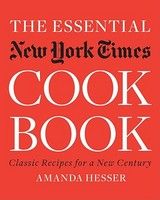
The Essential New York Times Cookbook Amanda Hesser
A few weeks ago, I had the pleasure of sitting down for a brief chat with Amanda Hesser, editor of The Essential New York Times Cookbook.
In the cramped upstairs offices of Green Apple, Ms. Hesser—gracefully recovering from the rain and lack of taxis—answered questions about the book, the editing process, and the effects of testing recipes on her young twins.
By way of introduction, this book, at 4.5 pounds, is a “doorstop”: 930 pages, over 1,000 recipes, lots of charts and graphs, and substitution lists. Asked what differentiates this from other “doorstop” cookbooks, she cited many features.
First, the book is culled from the archives of The New York Times, going back 150 years. For most of those years, most recipes were submitted by readers, usually women. So there’s a historical bent to the book, as revealed in the brief intro to each recipe. It was only in the 1970s or so, Ms. Hesser told us, that food writing graduated from the “women’s pages,” and the paper hired food writers and published recipes from chefs instead of readers.
To help decide what recipes to include, Ms. Hesser did some crowd-sourcing, asking readers to submit their favorite recipes. She received 6,000 suggestions (four of the top five were desserts, and four of the five were over 20 years old). Because of this, the recipes are truly diverse. Unlike some “doorstop” cookbooks, this is not just a contemporary take on classic recipes. Rather these are classic recipes.
Asked if she saw anything to rival the recent cupcake or charcuterie crazes, she mentioned that there was a period with lots of terrapin (turtle) recipes.
Finally, Ms. Hesser described how she personally tested 1,400 recipes. Her husband and young twins were the beneficiaries, eating everything from Laotian Catfish Soup to Bosiljka Marich’s Serbian Torte. While not all passed the twin test, the 1,000 recipes that made the cut have been carefully proofed, and joyfully consumed, in a home kitchen.
Other features include: • menu cross-referencing (i.e. this dish goes well with this dish) • timelines for each major chapter (how fish and shellfish evolved with the American palate) • many dishes that most “doorstop” cookbooks don’t include, setting you on a path of culinary discovery
The distinguishing feature is, indeed, the historical nature of this unique collection of recipes. It is NOT built around today’s tastes to a large extent (though the lion recipe in the archives did not make the book, alas). Rather it gives you an opportunity to explore America’s culinary history, discover old dishes, and try something new. And the book could be read like a narrative, which Ms. Hesser said was one of her goals.
As she said in her introduction, “relatively few of these recipes originated in the Times … so the archive is a mish-mash of the traditional, the innovative, and everything in between.” And as Twitter users suggested as a title, this is “All the Food That’s Fit to Eat.”



